
About UsThe Numismatic Bibliomania Society is a non-profit organization promoting numismatic literature. For more information please see our web site at coinbooks.org SubscriptionsThose wishing to become new E-Sylum subscribers (or wishing to Unsubscribe) can go to the following web page link MembershipThere is a membership application available on the web site Membership Application To join, print the application and return it with your check to the address printed on the application. Membership is only $15 to addresses in the U.S., $20 for First Class mail, and $25 elsewhere. For those without web access, write to: David M. Sundman, Secretary/TreasurerNumismatic Bibliomania
Society AsylumFor Asylum mailing address changes and other membership questions, contact David at this email address: dsundman@LittletonCoin.com SubmissionsTo submit items for publication in The E-Sylum, just Reply to this message, or write to the Editor at this address: whomren@coinlibrary.com
BUY THE BOOK BEFORE THE COINYou won't regret it! |
- WAYNE'S WORDS: THE E-SYLUM MAY 6, 2012
- KOLBE & FANNING BUY OR BID SALE NO. 1 CLOSES MAY 9. 2012
- WASHINGTON PATTERN COINAGE OF PETER GETZ SUPPLEMENT PUBLISHED
- NEW BOOK: THE WINCHESTER MINT
- NEW BOOK: 2013 U.S COIN DIGEST, 11TH EDITION
- NEW BOOK: TREASURE HUNT IN THE ENCHANTED FOREST
- A NUMISMATIC LIBRARY ON A CD
- BOWERS ON THE USEFULNESS OF REAL (PRINTED) NUMISMATIC BOOKS
- EXHIBITION OF GREEK MEDALS AT PRINCETON UNIVERSITY LIBRARY
- ANS EXHIBIT: SIGNS OF INFLATION
- GEORGE KOLBE ON NUMISMATIC GOSSIP
- QUERY: WHICH IS MORE DESIRABLE: HIGH CONDITION OR ACTUAL USAGE?
- MORE ON THE SCHULMAN MEDALLIC HISTORY OF MONEY AND BANKING
- MORE ON WEARING COTTON GLOVES
- THE MEDALS OF JOHN MERCANTI
- MORE ON FRANKLIN MINT PHILIPPINE ISSUES
- ROCKWELL FRANKLIN MINT SCOUTING MEDALS
- AUGSBURGER UNCOVERS A NEW IMAGE OF CHRISTIAN GOBRECHT
- WHO WAS HAYIM SOLOMON?
- MORE REFERENCES ON PALESTINE NUMISMATICS
- NOTES FROM E-SYLUM READERS: MAY 6, 2012
- YOUNG NUMISMATISTS AT STACK'S
- THE NEW JERSEY NUMISMATIC SOCIETY
- THE LAST CANADIAN CENT HAS BEEN STRUCK
- 2015 SWEDISH BANKNOTE DESIGNS SELECTED
- THE PERTH MINT
- MORE ON THE ART OF BANKNOTE FOLDING
- MAN ARRESTED FOR CARRYING A REAL $50 BILL
- PSYCHOTIC WOMAN TEARS UP BANKNOTES
- FEATURED WEB SITE: MONEYMUSEUM.COM
WAYNE'S WORDS: THE E-SYLUM MAY 6, 2012

New subscribers this week include Lin Golbeck. Welcome aboard! We have 1,549 email subscribers, plus 173 followers on Facebook. What is it with Facebook anyway? Our count there has plateaued - no one else likes us, or what?
Anyway, this week we open with a couple notes from Kolbe & Fanning, information on three new numismatic titles and two numismatic exhibits. Other topics include Christian Gobrecht, numismatic gossip, Greek medals, the medals of John Mercanti and young numismatists at Stack's.
To learn more about the Perth Mint, the Winchester Mint, conservatorship and cotton gloves, the psychotic woman's banknote tantrum, the wisest and wealthiest resident in the Enchanted Forest, and Hayim Solomon and the Star of David on the U.S. one dollar bill, read on.
Have a great week, everyone!
KOLBE & FANNING BUY OR BID SALE NO. 1 CLOSES MAY 9. 2012
 Kolbe & Fanning Numismatic Booksellers reminds bidders that their first 'Buy or Bid Sale' will close on this Wednesday, May 9. The online-only sale is designed to sell hundreds of lots cheaply, giving collectors an opportunity to add to their libraries at inexpensive prices. While hundreds of lots have already been sold, hundreds remain available. The PDF catalogue is available for downloading from the Kolbe & Fanning website at
www.numislit.com
.
Kolbe & Fanning Numismatic Booksellers reminds bidders that their first 'Buy or Bid Sale' will close on this Wednesday, May 9. The online-only sale is designed to sell hundreds of lots cheaply, giving collectors an opportunity to add to their libraries at inexpensive prices. While hundreds of lots have already been sold, hundreds remain available. The PDF catalogue is available for downloading from the Kolbe & Fanning website at
www.numislit.com
.
As the name of the sale suggests, customers may bid on items they wish to acquire or buy them outright at the published price. The Terms of Sale give full instructions on how to participate. Both bidding and buying will end Wednesday evening, with phone calls being taken till 6:00 p.m. Eastern Time and emails, voicemails and faxes received until midnight.
To further encourage participation, the firm is offering free postage to addresses in the U.S. for customers spending at least $500; also, there is no packing and processing fee for this sale. Again, please read the Terms of Sale before participating.
If you wish to be added to Kolbe & Fanning's email list, or if you have any questions about the sale, please write to David Fanning at df@numislit.com. He can also be reached at (614) 414-0855.
WASHINGTON PATTERN COINAGE OF PETER GETZ SUPPLEMENT PUBLISHED
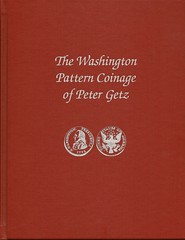 ANNOUNCING AN ILLUSTRATED SUPPLEMENT TO
ANNOUNCING AN ILLUSTRATED SUPPLEMENT TO
THE WASHINGTON PATTERN COINAGE OF PETER GETZ
Thanks to the efforts of George Fuld, the above mentioned book, published in 2009, has been brought up to date. For the benefit of purchasers of the original book, one duplication, two additional Getz copper specimens, and one brass Masonic medal have been recorded in the supplement.
The Supplement has been posted on the Kolbe & Fanning website and interested parties may download it at no cost at www.numislit.com .
To read an earlier E-Sylum article, see: BOOK REVIEW: THE PATTERN COINAGE OF PETER GETZ BY GEORGE FULD (www.coinbooks.org/esylum_v13n20a07.html)
NEW BOOK: THE WINCHESTER MINT
 I recently received a notice that the long promised [since the late 1970s, three of the contributors have died during its long period of gestation] monograph of the Winchester Mint (edited by Martin Biddle) was finally available. While my copy of the work has not arrived, its published table of contents strongly suggests that it will doubtlessly become a standard reference for those interested in the mediaeval English coinage.
I recently received a notice that the long promised [since the late 1970s, three of the contributors have died during its long period of gestation] monograph of the Winchester Mint (edited by Martin Biddle) was finally available. While my copy of the work has not arrived, its published table of contents strongly suggests that it will doubtlessly become a standard reference for those interested in the mediaeval English coinage.
The book is published by our friends at Oxford University Press, which along with their 'cousins' Cambridge University Press, have a long history of overcharging foreigners. Especially the Americans, doubtless because we are rich and stupid (many times they are at least half right).
In the US the book will be available from a number of sellers later this month:
Oxford University Press: http://www.oup.com/us/catalog/general/subject/Archaeology/European/?view=usa&ci=9780198131724 Where you can get it for the full retail price of $450.00
Amazon: http://www.amazon.com/Winchester-Studies-Related-Excavations-1961-71/dp/0198131720/ref=sr_1_1?ie=UTF8&qid=1335880770&sr=8-1 Where it is priced at $414.25
Barnes and Noble: http://www.barnesandnoble.com/w/winchester-studies-8-the-winchester-mint-martin-biddle/1103621169?ean=9780198131724 The cheapest at $398.16
The latter two offer free shipping, Oxford will charge you for this service. However, if you purchase the book from a British dealer the cost is £100.00 (about $150.00)!
It is available from Spink - email their book department at: books@spink.com
Blackwells: http://bookshop.blackwell.co.uk/jsp/id/The_Winchester_Mint/9780198131724
Amazon's British site has the work at £95.00: http://www.amazon.co.uk/Winchester-Studies-Related-Excavations-1961-71/dp/0198131720/ref=sr_1_1?s=books&ie=UTF8&qid=1335879975&sr=1-1
I paid, including air post and exchange rate, about $170.00. I will not say from whom, since all of these dealers are reputable.
As I said earlier, from the table of contents this should be a wonderful book for any student or scholar of the British series, but in this case if you live in the US and want to fill the hole in your library - buy British.
NEW BOOK: 2013 U.S COIN DIGEST, 11TH EDITION
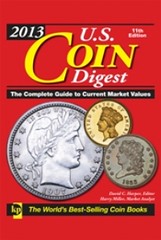 A new edition of U.S. Coin Digest, one of the most popular, easy-to-use resources for U.S. coin values, is now available from Krause Publications.
A new edition of U.S. Coin Digest, one of the most popular, easy-to-use resources for U.S. coin values, is now available from Krause Publications.
2013 U.S Coin Digest, 11th Edition is a fully illustrated guide to all United States coin issues offering the most up-to-date pricing in up to 11 grades. The spiral binding makes it easy for readers to read about the new Presidential dollar series, First Spouse Coins, Territory Quarters, and America the Beautiful Quarters. It includes all circulating and commemorative U.S. coins and features coins of Hawaii, Puerto Rico, and Philippines. Clear images and accurate prices make 2013 U.S. Coin Digest the only reference needed for collecting U.S. coins.
Other features include:
Binding that allows the book to lay flat on a table, creating the perfect "hands-free" tool for researching and pricing.
More than 1,000 high-quality color images from the nation's leading auction houses.
Thousands of accurate coin prices including all gold, platinum, palladium, and silver prices fixed to the most current market levels.
Author: Editor: David C.Harper
Market Analyst: Harry Miller
Price: USA $19.99 | CAN $18.99
ISBN: 9781440229596
For more information, see: http://www.sellcoinbooks.com/us-coin/2013-u-s-coin-digest-11th-edition
NEW BOOK: TREASURE HUNT IN THE ENCHANTED FOREST
Author Ian Lucas writes:
I recently co-authored a children's illustrated book on coins and the monetary system, Treasure Hunt in the Enchanted Forest: The Search for Good Money. It discusses historical evolution of the American system, the qualities of good and bad money, Gresham's Law, and more.
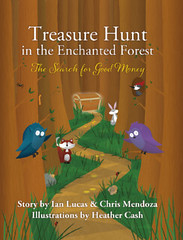 Grandpa Owl, the wisest and wealthiest resident in the Enchanted Forest, teaches his grandkids about kindness, fairness, and the secret to his riches. Follow along with Brother and Sister Owl as they learn lessons that students of top business schools do not receive. When you're done, you will be ready to go on your very own hunt for real treasure!
Grandpa Owl, the wisest and wealthiest resident in the Enchanted Forest, teaches his grandkids about kindness, fairness, and the secret to his riches. Follow along with Brother and Sister Owl as they learn lessons that students of top business schools do not receive. When you're done, you will be ready to go on your very own hunt for real treasure!
What others are saying:
Impossibly cute and just a tiny bit cunning, Treasure Hunt in the Enchanted Forest aims to teach kids a profound lesson about currency-one mom and dad surely will find eye-opening as well. History and economic lessons are cleverly hidden within a sweet, beautifully illustrated story crafted to enchant even the youngest readers. If you're curious about the true 'value of a dollar,' Treasure Hunt is worth its weight in gold.
~Jenna McCarthy, author of The Parent Trip: From High Heels and Parties to Highchairs and Potties
For more information, see: Treasure Hunt in the Enchanted Forest: The Search for Good Money (www.treasurehuntkidsbook.com)
A NUMISMATIC LIBRARY ON A CD
Bruce W. Smith writes:Awhile back I was searching for something on the internet and stumbled on to a CD for sale on eBay. As you may know, genealogy enthusiasts are putting lots of old books, such as county histories and other local history works, on CD and selling them at reasonable prices, usually $10 to $30. Often there are a dozen or more works on one CD.
I have often wished someone would do that with old numismatic works. Well, someone has. I ordered and received a CD containing around 100 (yes, a hundred) numismatic works, mostly from the 1800's, with a few from the 1700's and early 1900's. The CD also contains about 30 books on gold prospecting, gold refining, and goldsmith and silversmith markings. Some of these works are small -- under 100 pages -- but most run 200 to 500 pages. I have attached a list of some of them.
I contacted the seller, and he is the "maker" of the CD collection. He says so far he only sells them on Ebay, under the seller name: used_but_good_stuff. The CD I received is labeled "Vintage Gold and Silver Coins" but the item title on eBay is different. The heading reads: Gold Silver Coins - Hallmarks - Gold Silversmiths 130 Rare. The seller, Bill in Murrieta, CA says there are 130 titles on the CD. They are in PDF format and the CD is for use in a computer -- he says it won't work in a CD player or DVD player.
Most of the books are on Greek, Roman and British coins, but there are works on China, Japan, India, Mexico, Canada, United States and other areas. Also on the CD are single years of American Journal of Numismatics, Spink's Numismatic Circular, and the Numismatic Chronicle (Royal Numismatic Society). Of course, most of these works have been superseded by later works, but it is nice to have the older sources to look at. And the price for these 130 titles? Only $15.95 plus shipping. The only drawback I have found so far to this and similar CD's I have of Chinese works and works on Missouri history, is remembering what's on each disk
- Manual of Gold and Silver Coins of all Nations (1842)
- Illustrated Encyclopedia of Gold & Silver Coins of the World (1886)
- Numismatic Chronicle (1889; Royal Numismatic Society)
- Numismatic Circular (1895; Spink's)
- American Journal of Numismatics (1877)
- American Numismatical Manual (1859)
- Early Coins of America (1875; Crosby?)
- Exhibition of United States and Colonial Coins (1914)
- Mexican Imperial Coinage (1899)
- Coins, Tokens and Medals of the Dominion of Canada (1869)
- Catalogue of English Coins in the British Museum (1887)
- Silver Coins of England (1849)
- Catalogue of Scottish coins in the National Museum of Antiquities (1901)
- A Table of English Silver Coins (1745)
- Coins of the Romans Relating to Britain (1836)
- Coins of the Ancient Britons (1864)
- Catalogue of Greek Coins in the British Museum (1873)
- Coins of Ancient Sicily (1903)
- Catalogue of the Coins of Alexandria and the Nomes (1892; 531 pages)
- Greek Coins and the Parent Cities (1902; 521 pages)
- Ancient Coins of Greek Cities and Kings (1731)
- Coins of Parthia (1903; 412 pages)
- Catalogue of Imperial Byzantine Coins (1908; 455 pages; Wroth?)
- Carolingian Coins (1908)
- Jewish Coins (1903)
- Catalog of Chinese Coins (1892; Lacouperie, 504 pages)
- Coins of Japan (1880)
- Catalogue of the Collection of Oriental Coins (1774)
- Catalog of Oriental Coins in the British Museum (1875)
- Catalog of Coins in the Punjab Museum (1914; 583 pages)
- Coins of the Urtuki Turkmans (1875)
- Early Sassanian Inscriptions, Seals and Coins (1868)
- Catalogue of the Collection or Arabic Coins (1897; 387 pages)
- Coins of the Moghul Emperors of Hindustan (1892; 587 pages)
- Coins of Ancient India from the Earliest Times (1891)
BOWERS ON THE USEFULNESS OF REAL (PRINTED) NUMISMATIC BOOKS
Time was when there was a huge numismatic appetite for hardcover books. My History of the California Gold Rush book, 2002, was printed to the extent of over 4,000 copies and retailed for $150 or more and is now sold out. In 1979 my History of American Coinage as Illustrated by the Garrett Collection, a deluxe hardbound book, sold its first printing of 4,000 copies almost overnight, and all told 20,000 or more were sold. In 2012 I don't think that would happen, given equivalent books.
I can readily appreciate why the Encyclopedia Britannica folded its wings-for instead of spending $1,000 (or whatever) for a set of bound volumes, a reader can find much of the same information for free on the Internet. Years ago when I was writing an article and wanted to learn about Gulian Verplanck or Alexandre Vattemare, I needed to go to my reference library, take out a few volumes, look through them, and then pick out what I wanted to include in my research. Today in 2012 a few keystrokes will do it. Amazing.
And yet there is still something comfy about owning a real book. The new 2013 edition of the Guide Book of United States Coins (known as the 'Red Book') is on sale everywhere, backed by a print run in the hundreds of thousands of copies. It is one of the top-selling non-fiction titles ever published in the United States.
My advice: By all means use the Internet for information on poll statistics, the latest news, encyclopedic information, or what the world was like in 1890. But, when it comes to enjoying numismatics, build a library-a shelf full of interesting, useful, and inspiring books. They are something inspiring to hold on to, to have in your hand, and a world of enjoyment is at your fingertips. The list of Whitman titles is a good starting place.
Do you know when the first truly numismatically useful reference book was published in America? Here is the answer:
The year was 1839.
The initial volume of note was Joseph Barlow Felt's opus published this year, An Historical Account of Massachusetts Currency, an impressive 248 pages in length (first edition), the first book with an American imprint to treat in detail a numismatic subject. The work was not intended for collectors but, as the title indicates, dealt with the history of money and media of exchange of the Massachusetts colony.
Nevertheless, it was highly valuable and informative to numismatists. Legislation details and information about the well-known silver coins minted beginning in 1652, and of various paper money issues, were presented in a time-line sequence. A later edition of the book was 259 pages in length and included three plates (one of which illustrated the curious 1652-dated Good Samaritan shilling) and an index.
Nearly all of the information presented by Felt in 1839 is relevant and highly useful today. Imagine that!
To read the complete article, see: On the Usefulness of Real (printed) Numismatic Books (whitman.com/news/On-the-Usefulness-of-Real-printed-Numismatic-Books+1482)
EXHIBITION OF GREEK MEDALS AT PRINCETON UNIVERSITY LIBRARY
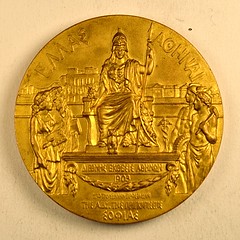 To showcase its recent acquisition of a collection of more than 120 medals of modern Greece, the Princeton University Numismatic Collection has installed an exhibition of a selection of historically important pieces in the Boyd Room of the Department of Rare Books and Special Collections in Firestone Library. The exhibition has been curated by Mary Thierry, Princeton Class of 2012, who has been working in the Numismatic Collection for the past three years and has taken the University's graduate seminar in numismatics. The medals will be on display for an indefinite period during hours when the department is open to the public.
To showcase its recent acquisition of a collection of more than 120 medals of modern Greece, the Princeton University Numismatic Collection has installed an exhibition of a selection of historically important pieces in the Boyd Room of the Department of Rare Books and Special Collections in Firestone Library. The exhibition has been curated by Mary Thierry, Princeton Class of 2012, who has been working in the Numismatic Collection for the past three years and has taken the University's graduate seminar in numismatics. The medals will be on display for an indefinite period during hours when the department is open to the public.
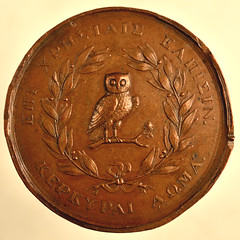
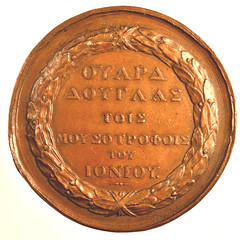
The collection was put together by a private collector in Athens and purchased by Princeton with funds from the Stanley J. Seeger Hellenic Fund and the Townsend-Vermeule Fund. It is believed to be the largest collection of modern Greek commemorative medals in an American public collection. Among the highlights of the collection and the current exhibition are a set of medals from1836 by the Austrian engraver Konrad Lange, who also engraved early coin dies for the newly established Greek Republic, and participation medals of the early Olympics, including the national Greek games that preceded the establishment of the International Olympic Games in 1896.
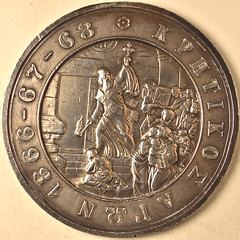
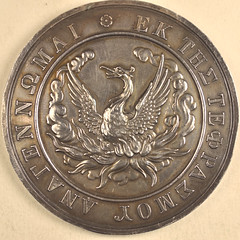
The public is invited to attend a celebration of the opening of the exhibition, and the graduation of its guest curator, on Thursday, May 31, at 4 p.m. in the Boyd Room. The Department of Rare Books and Special Collections is open to the public Monday through Friday, 9 a.m. to 5 p.m., closed holidays. Further information can be obtained from Alan Stahl, Curator of Numismatics, at astahl@princeton.edu or (609) 258-9127.
Alan adds:
As this whole field of early Greek medals is very poorly studied, I would appreciate any information your readers might have that would help us in cataloguing them.
ANS EXHIBIT: SIGNS OF INFLATION
François R. Velde writes:
You might want to mention the American Numismatic Society exhibit at the New York Fed on "signs of inflation". It was reviewed in Newsweek.
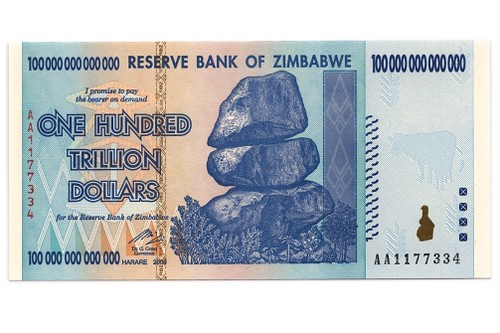
The worse a nation's economy, the more inflated its currency.
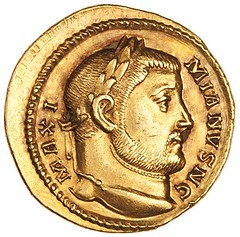 That's one of the takeaways from Signs of Inflation, a new exhibition at the Federal Reserve Bank of New York. The show, presented by the American Numismatic Society, looks at the history of inflation through the 7th century B.C. to present day. (Yes, even Ancient Rome experienced inflation-it needed to finance those wars.) Signs of Inflation includes almost 200 monetary objects, ranging from engraved gold coins and cowrie shells to twisted iron rods and handwritten IOUs. But it also demonstrates the myriad, complex ways a bank note-or coin, shell, or what have you-reveals a society's political and economic health. And it does so through treating money as partly an objet d'art
That's one of the takeaways from Signs of Inflation, a new exhibition at the Federal Reserve Bank of New York. The show, presented by the American Numismatic Society, looks at the history of inflation through the 7th century B.C. to present day. (Yes, even Ancient Rome experienced inflation-it needed to finance those wars.) Signs of Inflation includes almost 200 monetary objects, ranging from engraved gold coins and cowrie shells to twisted iron rods and handwritten IOUs. But it also demonstrates the myriad, complex ways a bank note-or coin, shell, or what have you-reveals a society's political and economic health. And it does so through treating money as partly an objet d'art
The exhibition's largest bill, in terms of monetary units, is from 1946 Hungary: a bank note, printed in July but never circulated, worth 1 sextillion pengö. The bill's design, which features a beautiful, serene-looking young woman, belies the fact that the country's monetary system was on the brink of collapse. Its worth at the time: 50 cents. Its worth after Hungary's new currency, the forint, was introduced in August of that year: 1/10,000,000 of a cent.
Visitors must make an appointment in advance to view the show.
To read the complete article, see: The Value of Worthless Money (www.thedailybeast.com//content/newsweek/2012/04/29/exhibit-considers-the-politics-and-art-of-inflation.html)
To read the complete Press Release, see: Signs of Inflation (numismatics.org/wikiuploads/NewsEvents/SignsofInflationPressRel.pdf)
For more information, see: Signs of Inflation (numismatics.org/Exhibits/SignsofInflation)
THE BOOK BAZARRE
GEORGE KOLBE ON NUMISMATIC GOSSIP
I disagree with Paul Bosco about his disagreement "with Charlie Davis about the Alan Weinberg recounting of his besting of Jack Collins and John Ford."
More to the point, dear editor, you have compounded the poor judgment exercised by running the initial account. Now, we are being treated to unwarranted assumptions about the matter based on, as Paul Bosco accurately puts it: "gossip".
"Just because it is gossip does not mean it is not information." Really? It is an unverified account that reflects unfavorably on the co-founder of NBS and another past member, neither of whom are around to defend themselves. "Others were more concerned about not have [i.e., having] to pay 'all the money' to some old lady." Really? How can that conclusion be properly made without input from the parties involved?
Three questions:
1) Would the recounting have been written if Jack and JJF were still around?
2) Would it have been published if Jack and JJF were still around?
3) Would Paul Bosco, assuming an affirmative response to queries 1 & 2, have made the same response if Jack and JJF were still around?
I have no way of gauging the accuracy of Alan Weinberg's commentary. Perhaps it is accurate; perhaps it is not. Assuming that it is, at the very least, context is lacking and it is incorrect to conclude that "Others were more concerned about not have [i.e., having] to pay 'all the money' to some old lady." If all three parties were great collectors, were not the two vying for the prize both "most concerned about acquiring a great piece" and were not both of them attempting to buy it at the lowest possible price?
It is wrong to print gossip, particularly when it reflects poorly on those who are no longer able to defend themselves.
In brief: gossip + conjecture = b--- s---.
To read the earlier E-Sylum articles, see:
NOTES FROM E-SYLUM READERS: APRIL 29, 2012: Bosco on Numismatic Gossip
(www.coinbooks.org/esylum_v15n18a16.html)
ALAN WEINBERG RECALLS JACK COLLINS
(www.coinbooks.org/esylum_v15n13a05.html)
QUERY: WHICH IS MORE DESIRABLE: HIGH CONDITION OR ACTUAL USAGE?
Dave Hirt writes:
This week I re-read the adventures of Alan Weinberg obtaining the James K Polk Indian Peace medal. While thinking about it, I recalled a post by Harvey Stack a few weeks ago, where he told about Lammot Dupont when he was buying an early American silver coin was not interested in a BU piece, but rather a lightly circulated one that had been handled by people, perhaps even some of our nation's founders.
The described Polk medal is a beautiful proof, but surely has never been on an Indian reservation. So, which would be more desirable - that piece, or an identical one, say, fine with some nicks and scratches and a small hole that was worn by a real Indian chief? (Living history.)
In my library I have books that picture Indian chiefs proudly wearing their medals, the oldest being Red Jacket wearing a large engraved medal of Washington. I guess it would depend on collector himself. Probably the condition fans would outnumber the history fans.
To read the earlier E-Sylum articles, see:
HARVEY STACK REMEMBERS LAMMOT DUPONT
(www.coinbooks.org/esylum_v15n13a13.html)
ALAN WEINBERG RECALLS JACK COLLINS
(www.coinbooks.org/esylum_v15n13a05.html)
MORE ON THE SCHULMAN MEDALLIC HISTORY OF MONEY AND BANKING
 I'd like to encourage Paul Bosco to recall the events he mentioned in last week's E-Sylum. He had a ringside seat to many numismatic bouts in New York City for the last three decades. His observations and commentary would certainly be of interest, irrespective if he was participant or observer.
I'd like to encourage Paul Bosco to recall the events he mentioned in last week's E-Sylum. He had a ringside seat to many numismatic bouts in New York City for the last three decades. His observations and commentary would certainly be of interest, irrespective if he was participant or observer.
I must correct his entry, however, on the Schulman series of medals, the Medallic History of Money and Banking. They were struck by Medallic Art Company not Franklin Mint as he stated (this negates two paragraphs of his entry).
The series began in 1971, issued monthly for 12 issues into 1972. The obverses were modeled by different sculptors, I have record of Patrick Whitaker creating number one, two and twelve. The reverse was modeled by Ramon Gordils from a single design, creating a common reverse for all. The choice of these sculptors tells me the series was on a fast track to prepare these quickly, rather than a more studied, artistic effort by perhaps a different set -- or a single sculptor.
In one of his statements, Hans Schulman stated that he choose Medallic Art Company because he could literally walk across Manhattan to Medallic Art's plant -- then at 325 East 45th Street -- from his office, then at 25 West 45th Street.
My records on this series are incomplete, and the reason for this is that Medallic Art was in a six-month planning and moving session during that first half of 1972 to relocate to Danbury Connecticut. This took place with the final day, June 2, 1972.
This had an effect on the Schulman series and reason for the fast-track sculpture, die making and striking before all the equipment was disassembled for the move to the new plant in Danbury.
At the time I cataloged the medals I had on hand and assigned the series a catalog number of 71-156. In 2000 the master number was revised to 1971-156. Each of the 12 medals carried their suffix serial number.
My appeal for information on this series mentioned in The E-Sylum brought a useful reply from Holly Ponsell, who earns my grateful appreciation. She furnished a scan of six pieces of literature, which, with my incomplete Medallic Art Company records, allowed me to piece together an account of this series I still cannot document fully who modeled issues three through eleven.
However, here is a list of the twelve medals in the series:
- 1971 Babylonian Marketplace Medal (obv by Patrick Whitaker, rev by Ramon Gordils) . . . .MAco 1971-156-001
- 1971 Croesus Establishes First Coinage Medal (obv by Patrick Whitaker, rev by Gordils) . . . MAco 1971-156-002
- 1971 Shekel Coin of 66-70 AD Medal . . . . . MAco 1971-156-003
- 1971 Marco Polo Discovers Paper Money Medal . . . . . . . . . . . . . . . . . . . . . . . . MAco 1971-156-004
- 1971 Accounting by Van Reymersvalle Medal . . . . . . . . . . . . . . . . . . . . . . . .MAco 1971-156-005
- 1971 Leonardo da Vinci Invents Coin Stamper Medal . . . . . . . . . . . . . . . . . . . . . MAco 1971-156-006
- 1972 Rothschild Family Banking Dynasty Medal . . . . . . . . . . . . . . . . . . . . . . MAco 1971-156-007
- 1972 Benjamin Franklin Medal. . . . . . . . . . . MAco 1971-156-008
- 1972 David Rittenhouse Medal. . . . . . . . . . MAco 1971-156-009
- 1972 American Gold Rush Medal. . . . . . . . MAco 1971-156-010
- 1972 International Trade Dollar Medal. . . . . MAco 1971-156-011
- 1972 New York Stock Exchange Medal (obv by Patrick Whitaker, rev by Gordils) . . . . . . . . . MAco 1971-156-012
The common reverse features an Egyptian Pharaoh Treasurer weighing gold rings with a Calf's-head weight. The scene is an exact reproduction of an Egyptian tomb painting (about 1400 BC). At left is a box containing additional gold rings, and above are other symbols of wealth, including a libation saucer and a bolt of exotic cloth.
Again, with additional thanks to Holly Ponsell. And a closing statement how useful sales literature and contemporary advertising can be for medallic research.
To read the earlier E-Sylum article, see: BOSCO ON THE SCHULMAN MEDALLIC HISTORY OF MONEY AND BANKING (www.coinbooks.org/esylum_v15n18a13.html)
MORE ON WEARING COTTON GLOVES
Anne Bentley writes:
In reply to Kay Freeman's query regarding gloves...At the Massachusetts Historical Society we require gloves for everything except books and manuscripts. We discovered that researchers do more damage to paper when they are wearing cotton gloves, since they aren't used to them and are clumsy in handling paper. Of course, we request that they wash their hands before sitting down to work...especially after lunch!
John Kleeberg writes:
The British Library receives this query a lot. White gloves are no longer considered best practice when handling manuscripts and rare books. The following two links explain why.
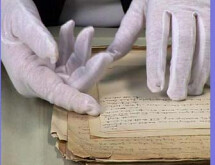 In general we do not use or provide
white gloves for use with collection
items. Clean dry hands, free from
creams and lotions, are preferable in
the majority of circumstances.
Wearing cotton gloves when handling
books, manuscripts or fragile paper
items reduces manual dexterity and
the sense of touch, increasing the
tendency to 'grab' at items. The cotton
fibres may lift or dislodge pigments
and inks from the surface of pages
and the textile can snag on page
edges making them difficult to turn. All these factors increase the risk of damage to
collection items.
In general we do not use or provide
white gloves for use with collection
items. Clean dry hands, free from
creams and lotions, are preferable in
the majority of circumstances.
Wearing cotton gloves when handling
books, manuscripts or fragile paper
items reduces manual dexterity and
the sense of touch, increasing the
tendency to 'grab' at items. The cotton
fibres may lift or dislodge pigments
and inks from the surface of pages
and the textile can snag on page
edges making them difficult to turn. All these factors increase the risk of damage to
collection items.
To read the complete article, see:
The use of white cotton gloves for handling collection items
(www.bl.uk/aboutus/stratpolprog/ccare/introduction/preservation/
usingcollections/whitegloves.pdf)
Awkward mobility. Loss of feeling. Impaired sensations. These are not descriptions of a trip to the dentist, but rather a visit to the reading rooms of many special collections where the experience of handling valuable rare books and documents is synonymous with donning white cotton gloves. This paper examines the effect of this well-meaning effort to protect our irreplaceable holdings from soiling in light of the potential for damage introduced by handicapping the handler. Routine hand washing is recommended as a more effective means of preventing the spread of dirt while improving the user's haptic response to and tactile appreciation of the collections.
To read the complete article, see: Misperceptions about White Gloves (archive.ifla.org/VI/4/news/ipnn37.pdf)
To read the earlier E-Sylum article, see: NOTES FROM E-SYLUM READERS: APRIL 29, 2012: On Wearing Cotton Gloves (www.coinbooks.org/esylum_v15n18a16.html)
THE MEDALS OF JOHN MERCANTI
Bill Burd writes:
What do they have in common? They all required Congressional approval.
Pete Smith writes:
I suggest there are at least two common elements in the list of medals mentioned by Dennis Tucker.
1. None of them are listed in Julian's Medals of the United States Mint The First Century.
2. All were executed by Mint sculptor/engraver John Mercanti.
Dennis Tucker writes:
Mercanti it is! That was the connection I had in mind. We're working with Mr. Mercanti on a book about the American Silver Eagle (he designed its reverse, of course), and one of the appendices is an illustrated catalog of his numismatic works. As far as I'm aware, this will be the first book-length study of the ASE ever published.
To read the earlier E-Sylum article, see: QUERY: U.S. MINT MEDAL IMAGES SOUGHT (www.coinbooks.org/esylum_v15n18a17.html)
MORE ON FRANKLIN MINT PHILIPPINE ISSUES
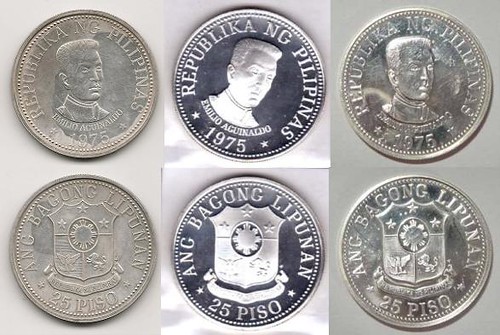
Franklin Mint Phillipine coin types - image courtesy Griff Ruby
Regarding Griff Ruby's questions about Philippine items issued by the Franklin Mint, Ray Czahor writes:
I have been a collector/dealer in Philippine Numismatics for the past 49 years. Yet I don't know the answers to most of the questions asked about Franklin Mint issues and don't know where there is a source other than maybe the Central Bank of the Philippines if they maintained any historical records on why the decisions were made.
Many of the Franklin issues do sell for less than original price but so do many recent US Mint issues. But there are Philippine collectors out there who will pay the going market price for these issues(much more than silver value)--I sell many of them in my annual Philippine Mailbid sales which I have been doing since 1999.
Also, especially since the gold market has increased significantly, thus the Franklin Philippine gold issues bring nice premiums now. Example, the relatively common KM213 President Marcos 1000 Piso Gold which originally sold for $125 from Franklin Mint, now sells for $500+. I hope this information helps.
To read the earlier E-Sylum article, see: QUERY: FRANKLIN MINT PHILIPPINE ISSUES (www.coinbooks.org/esylum_v15n18a14.html)
ROCKWELL FRANKLIN MINT SCOUTING MEDALS

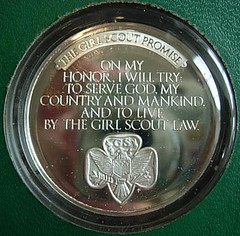
Boy Scout medal (left); Girl Scout medal (right)
Regarding Dick Johnson's piece on Franklin Mint medals, Greg Adams writes:
He mentions 'A Boy Scout medal series by Norman Rockwell sells at the greatest premium over original cost to my knowledge.' I suggest Dick take a look at the Silver and Bronze Girl Scout set (also with Rockwell images) that were issued a few years after the Boy Scout set. They are about 10 times rarer than the Boy Scout set, but still occasionally show up on eBay and sell for substantially more.
Franklin Mint Rockwell - Boy Scouts Spirit of Scouting Medals
(www.franklin-mint-silver.com/franklin-mint-rockwell-boy-scouts-medals.htm)
Franklin Mint Rockwell - Girl Scouts Medals
(www.franklin-mint-silver.com/rockwell-girl-scouts-medals.htm)
To read the earlier E-Sylum article, see: DICK JOHNSON'S ADVICE FOR FRANKLIN MINT CUSTOMERS (www.coinbooks.org/esylum_v15n18a15.html)
THE BOOK BAZARRE
AUGSBURGER UNCOVERS A NEW IMAGE OF CHRISTIAN GOBRECHT
 A recent research trip to Philadelphia uncovered
a new image of Christian Gobrecht, drawn
c. 1900 and based on a miniature of Gobrecht which
has appeared elsewhere (for example, in Gobrecht
Dollars Illustrated by the Collection of Julius Korein,
M.D., published by Heritage in 2009). A caption
reads "From a miniature in the possession of his
grandson, Chas. Gobrecht Darrach."
Darrach was a
grandson of Gobrecht who donated certain Gobrecht
papers to the Historical Society of Pennsylvania in
1906.
A recent research trip to Philadelphia uncovered
a new image of Christian Gobrecht, drawn
c. 1900 and based on a miniature of Gobrecht which
has appeared elsewhere (for example, in Gobrecht
Dollars Illustrated by the Collection of Julius Korein,
M.D., published by Heritage in 2009). A caption
reads "From a miniature in the possession of his
grandson, Chas. Gobrecht Darrach."
Darrach was a
grandson of Gobrecht who donated certain Gobrecht
papers to the Historical Society of Pennsylvania in
1906.
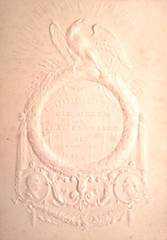 Also found was a trade card of Christian Gobrecht,
with the inscription 'C. Gobrecht / Die
Sinker / and / Seal Engraver / 220 / Walnut St. /
Philadelphia." Gobrecht, in his pre-Mint days, engraved
dies used for embossing cards and book covers.
This, his personal calling card, is a skillful tribute
to the engraver. Illustrated here is the familiar
eagle with talons bearing arrows and leaves, all surrounded
by a glory (evocative of Gobrecht's 1836
pattern gold dollar and later essayed on the 1853 arrows
& rays coinage), while profiles of Lafayette
and Washington grace the lower portion of the card.
Also found was a trade card of Christian Gobrecht,
with the inscription 'C. Gobrecht / Die
Sinker / and / Seal Engraver / 220 / Walnut St. /
Philadelphia." Gobrecht, in his pre-Mint days, engraved
dies used for embossing cards and book covers.
This, his personal calling card, is a skillful tribute
to the engraver. Illustrated here is the familiar
eagle with talons bearing arrows and leaves, all surrounded
by a glory (evocative of Gobrecht's 1836
pattern gold dollar and later essayed on the 1853 arrows
& rays coinage), while profiles of Lafayette
and Washington grace the lower portion of the card.
Gobrecht no doubt impressed many examples of this trade card, presumably one is out there waiting for a knowledgeable collector to find it!
To more information on the Liberty Seated Collectors Club, see: www.lsccweb.org
WHO WAS HAYIM SOLOMON?
A couple weeks ago, I got a note from Dave Hirt, who wrote:
This is a chain e-mail I received. Perhaps it would be interesting to our readers.
The note began:
Who Was Haym Solomon? Read this fascinating history of the $1 bill - all the way to the bottom to know about Haym Solomon.
You may be in for quite a surprise
I didn't have time to look into it, but it had the feel of an urban myth. The message began with a description of a number of the familiar elements of the One Dollar bill and the Great Seal of the United States, and the many instances of the number 13 - some intentionally, some coincidentally - representing the original 13 colonies:
13 signers of the Declaration of Independence ,
13 stripes on our flag,
13 steps on the pyramid,
13 letters in 'Annuit Coeptis',
13 letters in ' E Pluribus Unum,'
13 stars above the eagle,
13 bars on that shield,
13 leaves on the olive branch,
13 fruits, and if you look closely,
13 arrows.
And finally, notice the arrangement of the 13 stars in the right-hand circle. You will see that they are arranged as a Star of David.
I had seen the 13 stars a zillion times, but never saw them as a Star of David. This was news to me. But the email helpfully included a diagram connecting the dots. Hey! Maybe it was a Star of David.
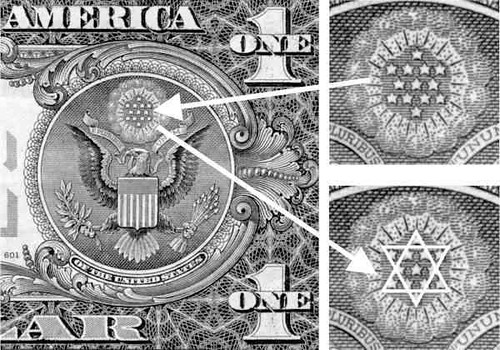
The email went on to say:
This was ordered by George Washington who, when he asked Haym Solomon, a wealthy Philadelphia Jew, what he would like as a personal reward for his services to the Continental Army. Solomon said he wanted nothing for himself, but he would like something for his people. The Star of David was the result. Few people know it was Solomon who saved the Army through his financial contributions ...then died a pauper.
I Googled around and learned that Solomon did indeed exist, but how could anyone prove the assertion that Solomon inspired the arrangement of stars on the Seal? I have a few books on the Great Seal on my shelves, but as much as I love numismatic research, I didn't have the time to review them.
Luckily, one of my favorite web sites came to the rescue this week. Snopes.com, a site that examines and busts Internet myths, published an article about this email. They write:
Hayim Solomon (whose name is also rendered as Haym Salomon) was a real person, a Polish-born Jew who immigrated to the American colonies in the 1770s, joined the
However, the claim that George Washington ordered the Great Seal of the United States to incorporate a Star of David element as a token of thanks to Solomon is apocryphal: Washington had no input into the design of the Great Seal, and the
original design specification for the Great Seal included no instructions about how the constellation of
The reason why artist Robert Scot chose to arrange that constellation of
So that's that - an interesting story, but most likely a tall tale.
To read the complete article, see: Who Was Hayim Solomon? (www.snopes.com/business/money/solomon.asp)
MORE REFERENCES ON PALESTINE NUMISMATICS
Bill Rosenblum writes:
I meant to write last week about other sources of information about Palestine numismatics but I'm knee deep in writing an auction catalog and sometimes I put things aside. In addition to Howard Berlin's book, the Dabbah book on Palestine Currency and Pridmore's work which have been already mentioned there are a number of other sources of information.
Richard Trowbridge wrote The Coinage of the Palestine Mandate, a small booklet in 1971, Sylvia Haffner's The History of Modern Israel's Money 1917-1970 (later released as Israel's Money and Medals) includes information about both coins and paper and The Guidebook and Catalogue of British Commonwealth Coins by Jerry Remickm and others all provide good information. In addition the late Fred Bertram's works on Israeli coins from 1966 and 1968 list Palestine coinage.
For more up-to-date pricing I would suggest looking at my price lists and auctions. Many of my old lists and catalogs are archived on my website at www.rosenblumcoins.com.
On another topic, I too was saddened to learn of the passing of Steve Pellegrini.
To read the earlier E-Sylum articles, see:
QUERY: LITERATURE ON PALESTINIAN NUMISMATICS
(www.coinbooks.org/esylum_v15n17a11.html)
NOTES FROM E-SYLUM READERS: APRIL 29, 2012: More on Palestine Numismatics
(www.coinbooks.org/esylum_v15n18a16.html)
NOTES FROM E-SYLUM READERS: MAY 6, 2012
A Note from Michael Sanders
New subscriber Michael Sanders of Beaverton, OR writes:
I just received my first issue of The E-Sylum. Thanks for the welcome as a new member. It was the recent article in Coin World by Joel Orosz that prompted me to sign on. I just spent 30 minutes cruising the articles and candid responses and found that Joel was not exaggerating in his glowing article.
I found the names of many numismatic friends, acquaintances and luminaries that I truly admire. My first inclination is to take a week off of work and spend the time exploring your wonderful creation and the remarkable ongoing input from so many people.
I'm sure that you will be hearing more from me once I read, absorb and learn to navigate E-Sylum. Keep up the great work!
On the Value of the British Penny
Joe Boling writes:
David Buik on the English penny: "After losing several hundred per cent of its value in the past two to three decades,..."
How, pray, does an item lose more than all of its value? It enters negative value, so is actively dangerous to have around?
To read the earlier E-Sylum article, see: ARTICLE: SHOULD BRITAIN ELIMINATE THE PENNY? (www.coinbooks.org/esylum_v15n18a24.html)
Corrections to the April 29, 2012 Issue
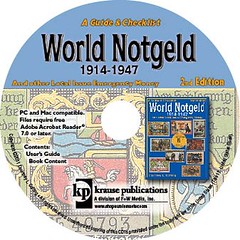 Steve Fahrlender writes:
Steve Fahrlender writes:
I was looking to purchase a copy of the World Notgeld 1914-1947, 2nd Edition Cd-Rom that you wrote about in the last E-Sylum. The link pointing to www.shopnumismaster.com does not work. I even went the their website and could not find it. I could not find where to purchase this item even after hours of Internet searching. Any idea on where to get hold of a copy of the CD-Rom?
Paul Landsberg, Joe Boling and Philip Mernick also reported the link problem. It had worked earlier in the week. I contacted Scott Tappa and apparently this page fell thru the cracks over the weekend while Krause switched to a new e-commerce software platform. Sorry! At least we know people are reading our book announcements and trying to add to their libraries. Last I checked the link was still broken, but stay tuned.
To read the earlier E-Sylum article, see: NEW BOOK: WORLD NOTGELD 1914-1947, 2ND EDITION (www.coinbooks.org/esylum_v15n18a06.html)
On ANA Convention Talk Videos
Kavan Ratnatunga writes:
I stumbled upon the website coinvideo.com in which I found a video DVD of a talk I did at the American Numismatic Association convention in 2004 for sale at $25, I did not recall that such a video was even made. If the copyrights are still with ANA, they should all be put free on YouTube
More On the Moneyer of St. Georges De Boscherville
Regarding the "funky dancing moneyer" on the cover of Kolbe & Fanning's Buy or Bid Sale No. 1, Bill Burd writes:
This illustration is also in "A Handbook to the Coinage of Scotland" by J. D. Robertson, printed by Argonaut, Inc., Chicago in 1968. It is in the introductory chapter on page xiv.
To read the earlier E-Sylum article, see: THE MONEYER OF ST. GEORGES DE BOSCHERVILLE (www.coinbooks.org/esylum_v15n18a11.html)
More on Nanotechnology for Banknote Security
Bob Neale writes:
"A major challenge with using banknotes is their rough fibrous surface, which necessitates adding a planarization layer to render the surface amenable to electrode and active layer deposition," says Alshareef. "We overcame this problem by applying a planarizing layer of polydimethylsiloxane (PDMS). In addition to acting as the planarizing layer PDMS provides other important roles such as providing adhesion and strain isolation for the devices above. A key feature of PDMS layer is that it penetrates deep into the fibers of substrates such as banknotes, thus providing strong adhesion without chemical bonding."
In regard to the article on RFID-tagged money, the above paragraph raises questions. I checked the reference provided, but could get no further than the abstract without a membership in the source site. I realize that the following might be too esoteric to be of interest, but here it is just in case.
PDMS, polydimethylsiloxane, is an inert polymer that might fill in spaces between, without binding to, fibers. But I doubt there would be any lasting retention as needed in something like circulating bank notes. At high molecular weights (number of repeating units), PDMS (with added silica, which is basically sand) is just silicone grease, and at lower MW without filler, it's silicone oil. Both are lubricants that work by not actually binding to anything. There are many modified dimethylsiloxane polymers, however, with other atoms deliberately built in that might afford the article's stated adhesion properties. So I wonder just what the polymeric bank note substrate is and whether the authors really mean PDMS, and of what molecular weight.
Further, the topmost of the 4 images in the graphic is a group of cyclic chemical structures. It does not represent PDMS (if it's supposed to) and looks more like a group of aromatic hydrocarbons. PDMS is linear, not cyclic, except for components of extremely low molecular weight. PDMS has two methyl groups, not one, attached to each silicon atom, which in turn is attached to one oxygen atom in repeating units, e.g. -Si(Me2)O- linked together in a repeating chain.
However, this article on RFIDs is another great example of just how far-ranging the field of numismatics really is. This core subject of ours involves chemistry, physics, and metallurgy as well as history, politics, and art. I think that a great course could be taught in colleges on just this idea, and I wonder whether that might actually be going on somewhere. One could call it, "Money, it's everything."
To read the earlier E-Sylum article, see: NANOTECHNOLOGY FOR BANKNOTE SECURITY (www.coinbooks.org/esylum_v15n18a22.html)
YOUNG NUMISMATISTS AT STACK'S
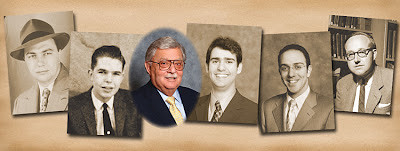
From the first time I worked (part time) at Stack's, I saw my father, Morton, and my Uncle Joe give special attention to young, budding collectors when they visited our offices and retail shop in the early 1940s.
My cousins Ben and Norman, Joseph Stack's sons, and I, Morton's son, were instructed and encouraged to help and pay attention to the young people, for they could become the numismatists and friends of the future.
The roster is long and many of the names legendary, but I will try to give some idea of the wonderful visitors we received through the decades.
I start with Cornelius Vermeule, who came to visit us in the late 1930s and early 1940s, accompanied by his father, as he added coins to his collection. Cornelius was a lover of classical ancient coins, U.S. coins (which he received from this grandfather and father), and was excited by coins of the Orient.
For a few summers Cornelius worked at Stack's sorting and cataloging coins. He went off to military service early in World War II. He was stationed in Japan at the end of the war and was selected, with his close friend Norman Jacobs, to inventory the Bank of Japan's numismatic holdings. Upon returning to the United States, a new book was written entitled 'Japanese Coinage' by Vermeule and Jacobs, published by Stack's.
Cornelius worked for us part-time in the late 1940s and then went on to be the Curator of Numismatics at the Boston Museum of Fine Arts. Later he became director of that museum. Stack's is very happy that one of our protégés went on to fame.
Another name, John J. Ford, Jr., was 'a wiz' of a numismatist, who worked part-time with Stack's prior to World War II. He did a lot of apprentice work in our offices. He entered the U.S. Army in 1942 and remained in Military Intelligence until he came home in 1946. His love for coins brought him back to Stack's where he worked until late 1947. He was encouraged as a youth and became a celebrated numismatist for nearly 60 years. Stack's always kept his friendship and relied on his great 'numismatic brain' to enhance its catalogs. He always said 'I went to Stack's as a youngster and graduated a numismatist.' His famous collection of mostly early Americana was featured in 21 catalogs, issued by Stack's. Stack's always encouraged John, and we are duly proud of his close association and long friendship with the Stack family.
One of the most exciting development programs we provided in the 1940s, 1950s, and 1960s was to be visited by the school coin club of the Pingry School, a well-known private school in New Jersey. During that time the history and economics teacher was Edward Knoke. He found by forming a coin club, he could advance the influence on his students of history and economics through numismatics. The members of the club had collections of classical coins through to modern world coins. Once a month or every six weeks on Saturday, the club would make a field trip to New York City. The first stop was always the Chase Money Museum, where curator Vernon L. Brown showed them the new displays and generally gave them a short talk.
Next stop was Stack's where they were welcomed, shown coins of their interest, and mingled with the famous collectors who visited Stack's each week. The Stack family and staff welcomed these budding collectors. To this very day, some of the members of the Pingry School Coin Club are still collectors.
Harvey adds:
It makes me remember all the years I spent in the shop at Stacks and some of the people we served and try to encourage to be collectors and some became great dealers. I hope everyone enjoys reading it. For me, it was really a personal trip "down memory lane"
Bruce W. Smith adds a question:
Harvey says that after World War II, Cornelius Vermeule and Norman Jacobs were selected to inventory the Bank of Japan coin collection. I would like to know, for whom did they do this inventory? Who selected them and why? For what reason was the collection inventoried? And what was the result?
There have long been rumors that Jacobs and Vermeule somehow acquired the Bank of Japan's collection of Japanese coins. Both of them have passed away now, so we can't ask them about it, and both of their collections have been sold. As far as I know, the Bank of Japan still has its collection. So what was the basis for those rumors?
To read the complete article, see: Remember When: Stack's Always Encouraged Young Numismatists (stacksbowers.com/Blogs/remember-when-stacks-always-encouraged.html)
THE NEW JERSEY NUMISMATIC SOCIETY
Dave Ginsburg writes:
I am writing to echo John Kleeberg's remarks. Like the Bronx Coin Club, the New Jersey Numismatic Society is, indeed, alive and well.
Our monthly meetings generally draw between 20 and 25 attendees. We normally meet on the third Monday of the Month at the Madison, NJ Library at 7:30 pm (except in February, when we meet in Chatham, and August, when we meet, along with other New Jersey clubs, at the ANA Convention). Our meetings generally feature a presentation on a specific topic followed by a general show-and-tell session.
Like the Bronx Coin Club, we were founded in 1933 and have numbered some impressive numismatists among our members. This tradition cointinues, as we count not only several numismatic luminaries, but also a number of officers of other New Jersey coin clubs, among our current members.
As the current president of the Society, I hope that the readers of The E-Sylum who live in or near New Jersey (or are just visiting) will take the opportunity to attend a meeting!
To read the earlier E-Sylum article, see: THE BRONX COIN CLUB (www.coinbooks.org/esylum_v15n18a21.html)
THE LAST CANADIAN CENT HAS BEEN STRUCK
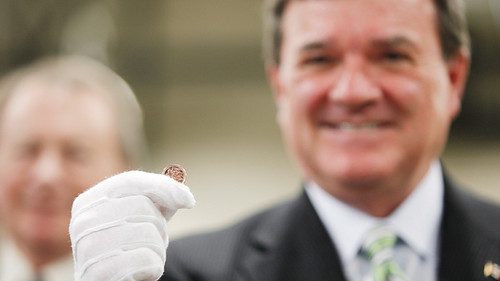
The last penny minted in Canada since its introduction in 1858 is on its way to the country's currency museum in Ottawa.
Finance Minister Jim Flaherty pushed the button just after 11 a.m. local time (noon ET) at the Royal Canadian Mint in Winnipeg.
After about a minute or so, the final coin dropped into a clear container from the side of the bright yellow press.
Flaherty picked up the penny wearing white gloves and held it up for a flurry of flashing cameras and television crews.
"It was very cool," he said when asked how it felt to push the button.
While the mint has found innovative ways over the years to cut costs and introduce new techniques in currency manufacture, the time had come to end production of an underused coin that's no longer vital to commerce, Flaherty said.
He hopes Canadians will donate their remaining pennies to charitable causes across the country.
The penny has been in use in what is now Canada since 1858 when the decimal system was adopted. The first coins in the Dominion of Canada were issued in 1870.
About 35 billion pennies have been issued since then, more than half of them in the last two decades.
Although there's no "end date" for the use of the penny, the government advises anyone wanting to cash them in to roll them up and take them to a bank
To read the complete article, see: Last Canadian penny on its way to Ottawa currency museum (www.ctv.ca/CTVNews/Canada/20120504/penny-last-winnipeg-flaherty-120504/)

2015 SWEDISH BANKNOTE DESIGNS SELECTED
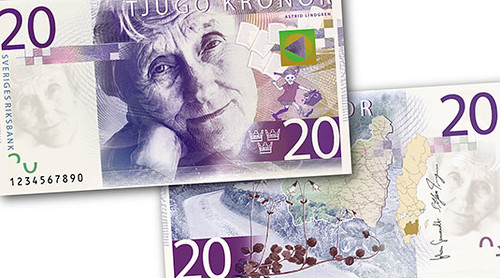
The General Council of the Riksbank has decided that the competition entry 'Cultural journey' will form the artistic basis for the design of Sweden's new banknotes. In April 2011, the General Council of the Riksbank decided on the motifs for the banknotes. After that a competition was launched to design the banknotes. A jury has been working on reviewing the entries received and has now chosen Göran Österlund's entry 'Cultural journey' as the winner.
'It has been a difficult but stimulating task to choose a winner. All of the entrants have presented ambitious and well-thought out proposals, but we finally decided on 'Cultural journey', says Peter Egardt, who is member of the General Council of the Riksbank and chairman of the competition jury. 'The overall impression is of a beautiful and user-friendly banknote series based on a fine balance of innovation and Swedish tradition.'
The jury's written decision states that this entry is a tightly cohesive series in which the different banknotes share a common idiom and the interplay of the face and reverse sides is unambiguous and harmonious. The jury also considers that the portraits take up a good-sized part of the face of each banknote and are well-suited for engraving. The reverse sides are clear and distinct and the motifs chosen seem typical of the relevant provinces.
The winning entry will be the artistic starting point for Sweden's new banknote series. This means that banknote designers will now adapt the winning proposal for finished banknotes. The banknotes will also be equipped with security features. The finished banknotes may therefore differ slightly from the winning proposal. The banknotes will probably be introduced in 2015.
To read the complete article, see: «Cultural journey» the winner of the Riksbank's design competition for the new Swedish banknotes (www.coinsweekly.com/en/News/4?&id=1185)
THE PERTH MINT
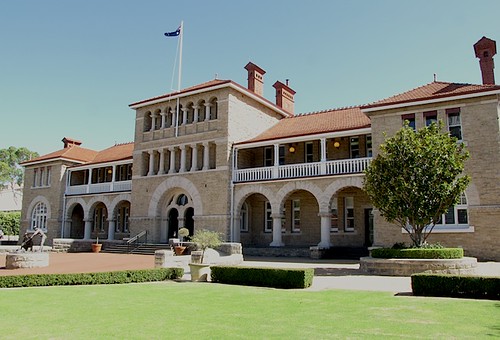
Established in 1899 under the auspices of the Royal Mint in London, the Perth Mint was charged with turning gold deposits from the Western Australian goldfields into gold sovereigns for use in the colony and throughout the British Empire, a practice that continued until 1931.
In the 1920s, the mint also started producing Australian coinage. Today, as one of the world's oldest mints still in operation, it predominantly produces collectable precious metal coins such as the Australian Nugget gold coin, the Australian Koala platinum coin, and the Australian Kookaburra silver coin.
Visitors to the mint have the opportunity to purchase these, plus plenty of gold jewelry from the front of the house shop. Most, however, head first on a 'behind the scenes' tour of the mint, checking out the replica 1890s-style 'gold mining camp', watching the modern production of coins from behind glass windows, and then taking a seat in the small auditorium (once the original Melting House) to see a traditional gold pouring performance. Run hourly, a mint employee first heats the pure gold to molten temperatures, pours it into the mold, cooling it quickly to create a 6 kg gold bar. A bit like magic really. Turns out it's more like 'groundhog day' with the same gold being melted over and over again.
But for me, however, the true highlight was standing on the 'gold scale' and discovering that my weight - in gold - was $2.5 million.
To read the complete article, see:
The Perth Mint: worth it's weight in gold
(travel.usatoday.com/alliance/destinations/perceptivetravel/post/
2012/04/The-Perth-Mint-worth-its-weight-in-gold/683674/1)
MORE ON THE ART OF BANKNOTE FOLDING
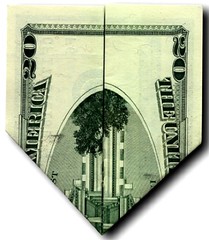 Legend: A properly folded U.S. $20 bill reveals images of the September 11 terrorist attacks on the World Trade Center and the Pentagon.
Legend: A properly folded U.S. $20 bill reveals images of the September 11 terrorist attacks on the World Trade Center and the Pentagon.
Origins: Folding common paper images such as currency and familiar product packaging to produce amusing (and often risqué) new images is a pastime with a long history. After all, several generations of kids have now learned that if you cut a few holes in a package of "Land O Lakes" butter and fold the portion with the pictured Native American girl's knees up just right, you can make it look like she's holding her breasts.
So, in that fine tradition, someone has recently discovered that folding a U.S. $20 bill a couple of different ways produces images that, with a little power of suggestion behind them, are reminiscent of pictures of the burning World Trade Center and Pentagon buildings after the
To those (few, we hope) who might be tempted to take something like this seriously, we'd simply point out that:
- The current U.S. $20 bill was the product of a redesign introduced by the U.S. Treasury back in
September 1998, a full three years before the terrorist attacks. - Since all denominations of U.S. currency higher than the
$2 bill feature an engraving of a building surrounded by trees and/or shrubbery on their reverse sides, it isn't difficult to find a bill that can be folded to create an image similar to that of a burning building (with the leaves or shrubbery functioning as the "smoke"). - The truly dedicated can even find a way to combine the letters in the printing to form the name of the perpetrator:
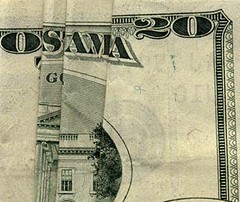
To read the complete article, see: Post No Bills (www.snopes.com/rumors/20bill.asp)
To read the earlier E-Sylum article, see: EVERYDAY ART: THE BANKNOTE (www.coinbooks.org/esylum_v15n18a28.html)
MAN ARRESTED FOR CARRYING A REAL $50 BILL
What officers thought was a counterfeit $50 bill turned out to be an old, legitimate bill, but the truth wasn't discovered until a man was mistakenly charged and jailed Friday. A clerk at Quik Mart, South Cannon Boulevard, notified police after the marker used to detect counterfeit bills didn't check as real.
"The front side of the bill was off center and it didn't feel like a normal bill, it did look to be counterfeit," officer Brock Horner said in his report.
After Lorenzo Gaspar was jailed, Horner showed the bill to Sgt. Bill Logue, the Shelbyville Police Department's evidence technician, who told him old legitimate bills wouldn't "check" with a marker and suggested he have it inspected at a bank.
Horner took the bill to two banks, where it was determined as "real but very old" at one and proven real by a black light and magnifying glass at another.
A judicial commissioner had Gaspar released from jail and Horner apologized for the arrest, the report said. Gaspar was told by Horner to take the bill to a bank and have it exchanged for a newer one.
To read the complete article, see: Old $50 bill found real, but not before bearer arrested (www.t-g.com/story/1843748.html)
PSYCHOTIC WOMAN TEARS UP BANKNOTES
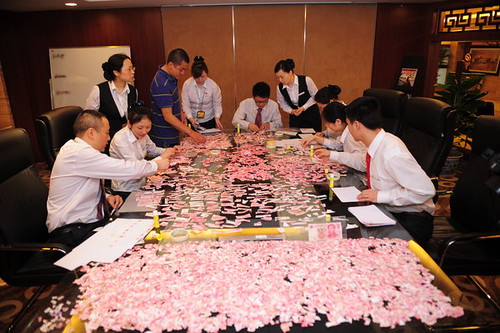

To read the complete article, see: 50,000 yuan bank notes torn by psychotic woman (europe.chinadaily.com.cn/china/2012-05/05/content_15216986.htm)
FEATURED WEB SITE: MONEYMUSEUM.COM
This week's Featured Web Site is MoneyMuseum.com.Here on the website of the MoneyMuseum - one of the first currency museums that presents its coin collection on the internet and since 2003 is physically accessible at Hadlaubstrasse 106 in Zurich - you will find numerous information about the history of Western key currencies and traditional means of payment.
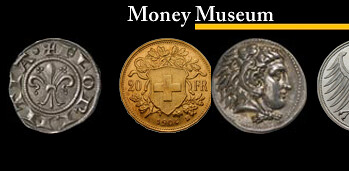
www.moneymuseum.com
